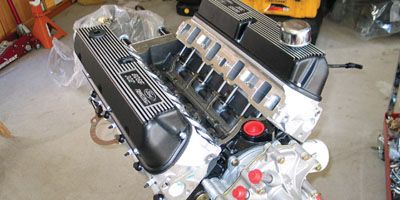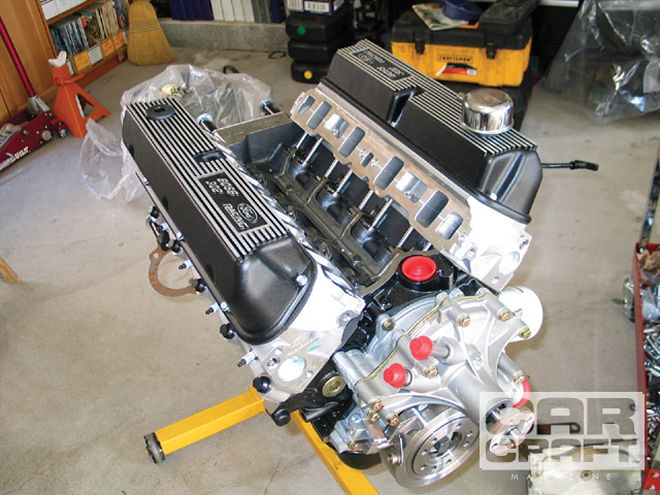
 The Boss 302 arrives looking just like this. To get it running, you'll need headers, an intake, a distributor, and some sort of pulley system. These engines have "Boss" and a serial number stamped on the rear bulkhead.
The Boss 302 arrives looking just like this. To get it running, you'll need headers, an intake, a distributor, and some sort of pulley system. These engines have "Boss" and a serial number stamped on the rear bulkhead.
We love the Ford 302. Its short, 3.00-inch stroke encourages flinging the tach needle to 7,000 or even 8,000 rpm, and its fat, 4.00-inch bore allows mucho cylinder head breathing. We've punished a 5.0L from an '88 Mustang with a 618hp blast with an ATI centrifugal supercharger, and more recently, we plucked a junker 302 from a wrecked Ranchero and built our way to 479 hp using race gas and a gigantic solid lifter camshaft. You can't claim the engine isn't versatile.
Even though we've made good power with boost and octane, we've always known the core of the engine is based on a two-bolt main block and a nodular iron crankshaft. We've proved the short-block's resistance to short blasts of boost and rpm on the dyno, but what about street longevity? At 7,500 rpm, the crank is squirming around and the caps are moving. That eats bearings-and eventually something will fail.
That's why we were geeked when we heard about the launch of the new Boss 302, a sweet upgrade to our favorite small-block Ford engine. Not only does the new Boss have the nickname from the late '60s to wow the Mustang guys, but it also has a four-bolt main block and a forged-steel crankshaft to back it up.
The engine is offered from Ford Racing with a suggested retail price of $6,695.00. It arrives as a complete long-block with a rear-sump oil pan for the Fox chassis, a neutral balance 157-tooth flywheel, a balancer, a reverse-rotation water pump, Boss valve covers, and a dipstick. At the core is a new production iron block with splayed four-bolt main caps that can be punched to a bore of 4.125 with a maximum stroke of 3.400. It has a steel crank and rods and forged 9.0:1 pistons. You also get either the B303 hydraulic roller cam ground for manual transmission or the E303 hydraulic roller that is recommended for automatics or manuals.
We tested the Boss 302 crate engine with three different intakes to make the selection process easier for you and to see if it made the advertised power. We also wanted to see if we could improve it a bit without wrecking the 12-month, 12,000-mile warranty. Check it out.
What's The Diff?
We thought to show you the differences between the stock 302, the '69 to '70 Boss 302, and the new Boss blocks.
Stock 302 ’69-’70Boss 302 FR Boss 302 Main caps Two-bolt cast iron Four-bolt cast iron Four-bolt nodular iron machines splayed Siamese bore No No Yes Freeze plugs Press Screw-in tapered pipe thread Screw-in O-ring sealed straight thread Material Cast iron Cast iron Diesel-grade heat-treated cast iron Heat bolts 7/16 7/16 1/2 Maximum bore 4.030 4.030 4.125 Main bolts 7/16 7/16 1/2 Oil galley plugs Pipe thread and press in Pipe thread Screw-in O-ring sealed straight thread Hydraulic roller compatible Yes No Yes Clutch cross-shaft pivot hole No Yes Yes Rear main seal One-piece Two-piece One-piece Maximum cid 347 347 363 *Chart courtesy of Ford Racing
Huh? What's A Boss?
In 1969 Ford was required to build 1,000 Boss 302 Mustangs and sell them to the public to qualify for Trans-Am competition. The first Boss engine designed for this had a 302 short-block and used Tunnel Port heads that produced a reported 450 hp, but high-rpm longevity issues (parts-flinging explosions) coupled with the high cost of production and terrible street manners made them track-only. The Boss 302 that ended up in the street version of the Trans-Am car in 1970 was a 302 short-block with a version of the then-new 4V Cleveland head. It was better than the Tunnel Port, but the 2.23/1.71 valves and a four-finger intake port made a steep gear and high revs a necessity. The '69 to '70 Boss has four-bolt main caps instead of the standard two, a forged-steel crank and rods, 10.5:1 pistons, and distinctive screw-in freeze plugs. The new Boss 302 uses the strength of the four-bolt caps and forged rotator, the look of the Boss screw-in plugs, and production Windsor-style cylinder heads that flow at street-rpm levels. Aside from the '69 to '70 Boss 302 intake manifold and headers, all the parts from these three engines are interchangeable.